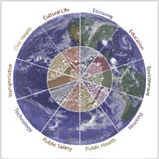You are here
Scantegrity

Does your vote count and will it be so, correctly? Scantegrity is a research and open source project, that has developed an election verification sytem that will allow voters to ensure their vote has been tallied while maintaining anonymity. The technology works in conjunction with one of the most popular voting techniques in the US - optical scanning, in which voters fill in a bubble on a paper that is then scanned for a computer record, as well as leaving a smart paper trail. The new Scantegrity's encryption technology uses new ballots with invisible ink that produce a unique confirmation code when the bubbles are filled in, such that it deterministically corresponds with the choice of candidate and this cannot be because falsified or traced to the voter because of the encryption. The ballots are then processed using the same optical scanning machines already in use across the country. This voting technology gives individual voters the power to check and dispute their vote by allowing them to check their confirmation code online to determine that their ballot was counted toward their desired candidate.
*The November 2009 municipal elections in the progessive town of Takoma Park, will mark the first time that Scantegrity is used for a binding public election
*In in April 09 it has been sucessfully tested in a mock election in conjunction with the Takoma Park Arbor Day celebration as well as for University of Maryland's Maryland day test Election.
Scantegrity is a security enhancement for optical scan voting systems, providing such systems with end-to-end (E2E) verifiability of election results. It uses privacy-preserving confirmation codes to allow a voter to prove to themselves that their ballot is included unmodified in the final tally.
Scantegrity II prints the confirmation codes in invisible ink to improve usability and dispute resolution. As the system relies on cryptographic techniques, the ability to validate an election outcome is both software independent as well as independent of faults in the physical chain-of-custody of the paper ballots. The system was developed by a team of researchers including cryptographers David Chaum and Ron Rivest.
Hi Christine,
You have permission to use the image for the purpose you described. I understand the page is related to activities pertaining to Boston, so I don't know if it will fit the focus of your article, but I should just add that the Scantegrity project involves members from 5 universities across the U.S. and Canada.
Also, if you send us a link to the description, we'll post it on our blog!
regards,
Aleks Essex
- Log in to post comments



